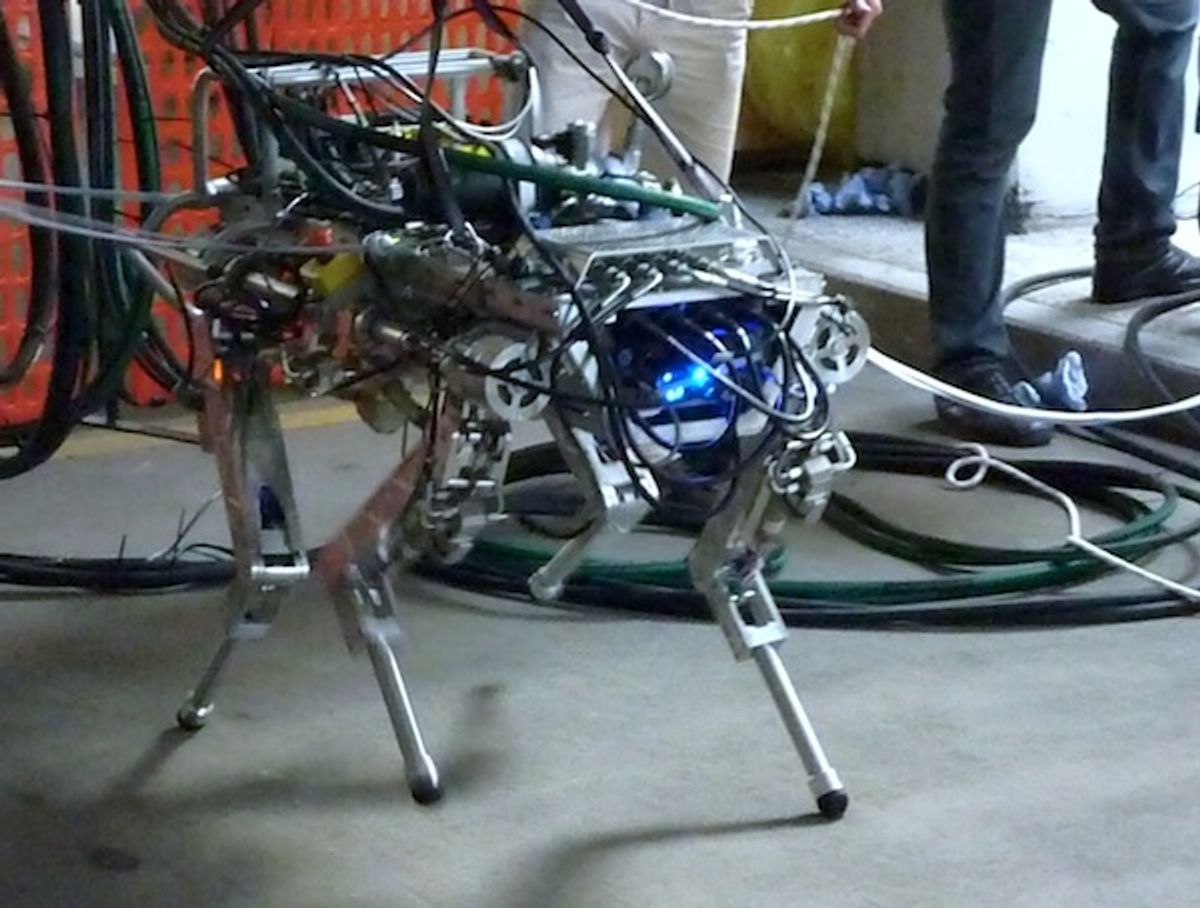Last week, researchers from the Italian Institute of Technology took their quadruped robot HyQ for a test run outside the lab for the first time. The researchers were anxious to try some new tricks HyQ has learned, including the ability to trot over obstacles without falling. The robot is still a strange headless creature, and though a sensor head is in the works, this quadruped might get even weirder with a new hardware addition: arms. Yes, arms.
HyQ, built by a team from IIT’s Department of Advanced Robotics, in Genoa, is a hydraulic robot that relies on torque-controlled, actively compliant actuators. The goal of the project is to create an autonomous, versatile machine capable of running, jumping, and negotiating rough terrain that could find applications in search-and-rescue operations and exploratory missions.
The team, led by Professor Darwin Caldwell, will discuss recent improvements made to the robot's control system at the 2012 IEEE International Conference on Robotics and Automation, which happens this week in St. Paul, Minn.
The researchers had previously tested HyQ on a special treadmill, when the robot achieved 1.7 meters per second. During last week's outdoor trials, the robot ran free on a 20-meter long concrete track (or mostly free—the researchers installed a safety harness above the robot, and a tether provided hydraulic power). HyQ reached a new top speed of 2 m/s with a walking trot gait, and the researchers expect it could go even faster when more space is available. Watch:
One big upgrade is that the control system now uses data from the on-board inertial measurement unit, or IMU, a Microstrain device running at 1 kilohertz, the same frequency of the servo controllers. The data allows the robot to react to disturbances and maintain a predetermined posture. When it trips on an obstacle, for example, it can correct its steps and avoid a fall.
"We're able to do balance control with reactive steps," says Claudio Semini, the IIT researcher responsible for HyQ's hardware and a founding member of the project. "The robot reacts to what's happening on the spot."
The researchers acknowledge that their robot still needs improvements before it can achieve the performance levels of Boston Dynamics's famed quadrupeds, BigDog and AlphaDog, which can climb slopes, walk over icy surfaces, and even keep their balance after getting kicked.
"We haven't kicked our robot yet," says Jonas Buchli, team leader of the HyQ project and a locomotion software expert. "But it's starting to look eerily similar [to the way BigDog walks] … It looks almost like an animal."
The IIT team is working with an Italian company to equip the robot with an on-board hydraulic system, which would eliminate the tether, an upgrade that should happen over the next several months. Another improvement is to add more sensors, including a Velodyne LIDAR, for mapping and navigation. (The researchers will describe HyQ's systems in research papers but do not plan to make all hardware and software open source.)
And soon, HyQ will get a pair of manipulation arms, becoming, in effect, a kind of robotic Centaur [see CAD images below showing conceptual designs of the arms in stowed and extended configurations]. “We want to combine the advantages of both legs and arms,” Buchli says. ”Adding manipulation to a stable locomotion platform opens up some interesting possibilities.”
Images and video: IIT
Erico Guizzo is the director of digital innovation at IEEE Spectrum, and cofounder of the IEEE Robots Guide, an award-winning interactive site about robotics. He oversees the operation, integration, and new feature development for all digital properties and platforms, including the Spectrum website, newsletters, CMS, editorial workflow systems, and analytics and AI tools. An IEEE Member, he is an electrical engineer by training and has a master’s degree in science writing from MIT.




